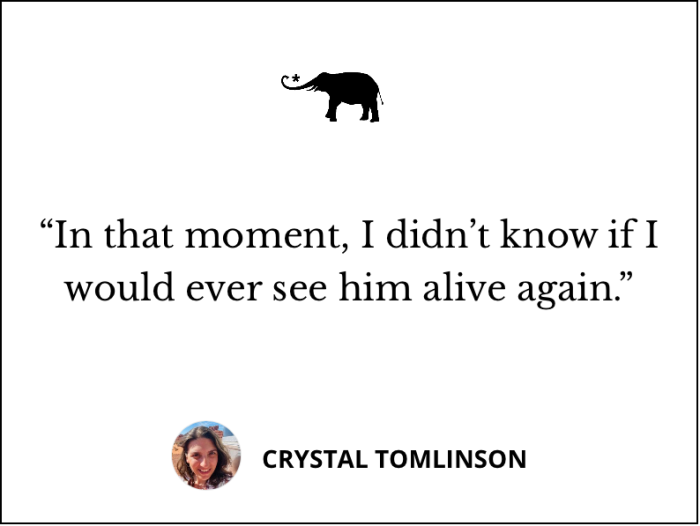*Note: This piece is the first of a two-part series. Check out the second part here.
He gently shook me and in a breathless voice said, “Babe, wake up. You need to get dressed. I think we need to call an ambulance.”
My eyes snapped open, what?! Call an ambulance?
He’d already taken three nitroglycerin pills. These tiny white pills are prescribed for angina, a condition that can mimic a heart attack, and they work very quickly. If the chest pain doesn’t stop within 10 to 15 minutes, it’s not angina.
It is a heart attack.
For the third time, I asked him, “You really want me to call 9-1-1?”
I was in disbelief and didn’t know if I’d heard him clearly. In the early days of my husband’s heart disease, he didn’t have a nitro prescription. During those earlier times when his heart was acting weird, we’ve always driven ourselves to the Emergency Room.
It was always after a troublesome episode (or a few) that had already passed.
When his chest hurts and is heavy with pressure. When his jaw is sore or his left arm is numb, and he can’t catch his breath.
Always, the episode passes but lingers in our minds, signaling something serious. So, we’ll make a plan and go to the ER to find out what’s going on.
This time, there was no time for that.
There was no time for us to prepare for a long hospital visit. No time to pack a bag, to choose comfy clothes or grab a sweatshirt to stay warm in the often-cold hospital rooms. There was no time to gather laptops or iPads, charging cords, and headphones to help pass the time as we wait hours upon hours for test results and doctors’ rounds. There was no time to feed the animals or let the dog out to relieve himself before leaving the house.
This time, there was no time to lose.
My husband was having a heart attack.
We wouldn’t get to the hospital fast enough on our own. So, sitting on the floor at his feet, shaking with nerves yet feeling an eerie sense of calm, I dialed 9-1-1.
Eight minutes later, I heard the sirens.
I walked outside to flag them down, making sure they knew which house was ours.
As they turned onto our cul-de-sac, I noticed my elderly neighbor outside bringing up her blue recycling can from the curb. She smiled and waved at the fire truck, and I felt an instant dread, worrying they might think it was her house they were called to.
I thought it plausible that the EMTs would naturally think this woman’s older husband was having a heart attack instead of my just-turned-49-year-young one. I feared they would go to her house by mistake, wasting precious time that we were running out of.
Panicking, I jumped up and down, waving my arms wildly above my head screaming, “No! Please! Over here!”
They got my signal. I went back in and stood to the side as six men in uniform stormed into my house with fierce determination and purpose. I’d never experienced an emergency like this before. It was a shocking and traumatic moment, but I was feeling oddly calm and somewhat detached as it was happening.
Soon, after answering some questions, I began to lose some of my cool and collected composure.
They needed my husband’s wallet, so I ran to our bedroom closet and frantically searched, trying desperately to find it quickly. I was throwing things off the shelves, seeing business cards and random papers flutter through the air, hearing soft thumping of loose change as it fell and hit the carpeted floor.
I gave up looking after about a minute and ran back to see him already up on a stretcher and rolling out the front door.
It all happened so fast.
I barely had a chance to say goodbye, to touch him one last time, to tell him I loved him. I quickly leaned over the back of the stretcher and kissed him. I told him to please hang on, please be okay.
In that moment, I didn’t know if I would ever see him alive again.
I couldn’t ride in the ambulance because this was at the height of the pandemic and Covid-19 protocols wouldn’t allow it. Before I knew it, everyone was gone, and my house was empty.
I stood in the middle of my living room, noticing the silence, an extreme contrast to the recent commotion in my home. I hung my head in my hands and finally let the tears flow. I bawled my eyes out, crying loudly, releasing the dam of emotions I’d been keeping in check.
I allowed myself this one moment of weakness. I let go of my precarious hold of the strength I’d had a death grip on for the last 45 minutes since I was shaken awake that morning.
After my emotional release, I set my mind to the coming task at hand, gathered back my strength, and prepared for the next leg of this experience. I fed my animals and gave the dog some time outside. I filled my bright green Hydro Flask with cold water and gathered my distraction devices.
I made sure to grab my husband’s phone—refusing to believe he wouldn’t need it soon and drove myself to the hospital.
I left his things with an ER employee who was sitting in the entrance, screening patients, and stopping visitors from coming inside. I wasn’t allowed to be with him in the hospital which added another level of fear and anxiety, but I refused to go back home.
It was a scorching July day in south Texas, so I found a semi shaded spot under a young tree in the concrete parking lot. I rolled down my windows, turned off the ignition, and waited for the call to tell me if my husband lived or died.
Hours later, still parked outside the hospital and sweating in my truck, the call hadn’t come. I was doing a good job of burying my fear up to that point, but the shovel was becoming hard to grip in my slippery hands.
I didn’t know what was going on and it was difficult to get through to anyone who knew anything. I decided on a whim to try calling my husband’s phone and to my astounding disbelief, he answered.
He was alive!
My husband was very lucky that day. His heart held on for close to three hours, three agonizing hours of immense pain and difficulty breathing.
His heart held on in the ambulance and kept beating through his fear as he watched the paramedics get the paddles ready—preparing to shock him in case it stopped on their way to the ER.
It held on and kept beating through the pain and loneliness as he laid in a trauma room all alone without my hand to hold—the morphine and solitude provided little comfort.
His heart held on and continued to stubbornly beat despite the artery that was 100 percent blocked; held on and never stopped while his cardiologist rushed to the hospital and performed an emergency angioplasty to open the artery up.
My husband said the pain stopped instantly when the balloon was inflated, stretching and restoring blood flow through the artery and to his heart.
This time, he was extremely lucky to be alive.
Three years later, my husband is still here, and I’d like to say alive and well, but his last heart attack also came with a severe lung disease diagnosis. When his lungs flare up with sickness, his heart is affected and right now, his heart is not happy.
Recently, he’s had to take the nitroglycerin more times than I am comfortable with. Fortunately, not every episode of chest pain is a heart attack. But every time those pills come out is a chance that it is.
Every time is a chance that it’s happening again, a chance we’ll have to call 9-1-1.
Every time is a chance that could be his last.
*Author’s Note: I write my story to spread mental health awareness. My mission in sharing my depression healing journey is to give hope and support to others going through something similar.
I’ve often had to deal with scary circumstances like these which I believe have contributed to my depression. It can be a rollercoaster of emotions that are hard to manage when fear kicks in. I’m only just beginning to learn healthy ways of coping, but being an imperfect human, I still struggle sometimes.
If you are struggling with depression due to health issues for yourself or loved ones or for any other reason, please know that you loved and are not alone. ~Crystal
*Note: This piece is the first of a two-part series. Check out the second part here.

 Share on bsky
Share on bsky







Read 10 comments and reply